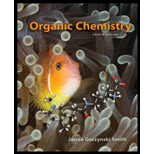
Concept explainers
(a)
Interpretation:
To find the higher boiling point in the given compound pairs.
Concept introduction:
Boiling point is the physical properties of the compound. It is the temperature at which the liquid is converted to gas. The stronger the intermolecular forces, the higher the boiling point. The boiling point increase in the order of
Hydrogen bonding > dipole-dipole interaction > Van der Waals force
The more the polarizable the atom, higher is the boiling point.
(b)
Interpretation:
To find the higher boiling point in the given compound pairs.
Concept introduction:
Boiling point is the physical properties of the compound. It is the temperature at which the liquid is converted to gas. The stronger the intermolecular forces, the higher the boiling point. The boiling point increase in the order of
Hydrogen bonding > dipole-dipole interaction > Van der Waals force
The more the polarizable the atom, higher is the boiling point.
(c)
Interpretation:
To find the higher boiling point in the given compound pairs.
Concept introduction:
Boiling point is the physical properties of the compound. It is the temperature at which the liquid is converted to gas. The stronger the intermolecular forces, the higher the boiling point. The boiling point increase in the order of
Hydrogen bonding > dipole-dipole interaction > Van der Waals force
The more the polarizable the atom, higher is the boiling point.
(d)
Interpretation:
To find the higher boiling point in the given compound pairs.
Concept introduction:
Boiling point is the physical properties of the compound. It is the temperature at which the liquid is converted to gas. The stronger the intermolecular forces, the higher the boiling point. The boiling point increase in the order of
Hydrogen bonding > dipole-dipole interaction > Van der Waals force
The more the polarizable the atom, higher is the boiling point.
Want to see the full answer?
Check out a sample textbook solution
Chapter 3 Solutions
Package: Organic Chemistry With Connect 2-semester Access Card
- hi! i need answers on letters d to f. The instructions says give the IUPAC name of each compound. Thank u!arrow_forwardThe shrub ma huang (Section 5.4A) contains two biologically activestereoisomers—ephedrine and pseudoephedrine—with two stereogeniccenters as shown in the given structure. Ephedrine is one component ofa once-popular combination drug used by body builders to increaseenergy and alertness, whereas pseudoephedrine is a nasaldecongestant.a.) Draw the structure of naturally occurring (−)-ephedrine, which has the1R,2S configuration.b.) Draw the structure of naturally occurring (+)-pseudoephedrine, whichhas the 1S,2S configuration.c.) How are ephedrine and pseudoephedrine related?d.) Draw all other stereoisomers of (−)-ephedrine and (+) pseudoephedrine, and give the R,S designation for all stereogeniccenters.e.) How is each compound drawn in part (d) related to (−)-ephedrine?arrow_forwardFive isomeric alkanes (A–E) having the molecular formula C6H14 are each treated with Cl2 + hv to give alkyl halides having molecular formula C6H13Cl. A yields five constitutional isomers. B yields four constitutional isomers. C yields two constitutional isomers. D yields three constitutional isomers, two of which possess stereogenic centers. E yields three constitutional isomers, only one of which possesses a stereogenic center. Identify the structures of A–E.arrow_forward
- Draw and name all constitutionally isomeric alcohols with the molecular formula C4H10Oarrow_forwardDraw the product obtained when cis-2-butene is treated first with Br2 in CH2Cl2, second with NaNH2 in NH3, and then finally with Li in NH3.arrow_forwardDetermine the molecular formula based on the information provided.A ketone with M+ = 192 that has4 degrees of unsaturationAn ether with M+ = 154 that has2 degrees of unsaturationarrow_forward
- Rank the following groups in order of decreasing priority. −CH=CH2, −CH3, −C≡CH, −Harrow_forwardCompound X is optically inactive and has the formula C 16H 16Br 2. On treatment with strong base, X gives hydrocarbon Y, C 16H 14. Compound Y absorbs 2 equivalents of hydrogen when reduced over a palladium catalyst and reacts with ozone to give two fragments. One fragment Z, is an aldehyde with formula C 7H 6O. The other fragment is glyoxal, (CHO)2. Which of the following answers is correct? Select all that are correct.arrow_forwardRank the following groups in order of decreasing priority. a.−F, −NH2, −CH3, −OH b.−CH3, −CH2CH3, −CH2CH2CH3, −(CH2)3CH3 c.−NH2, −CH2NH2, −CH3, −CH2NHCH3 d.−COOH, −CH2OH, −H, −CHO e.−Cl, −CH3, −SH, −OH f.−C≡CH, −CH(CH3)2, −CH2CH3, −CH=CH2arrow_forward
 Organic ChemistryChemistryISBN:9781305580350Author:William H. Brown, Brent L. Iverson, Eric Anslyn, Christopher S. FootePublisher:Cengage Learning
Organic ChemistryChemistryISBN:9781305580350Author:William H. Brown, Brent L. Iverson, Eric Anslyn, Christopher S. FootePublisher:Cengage Learning
